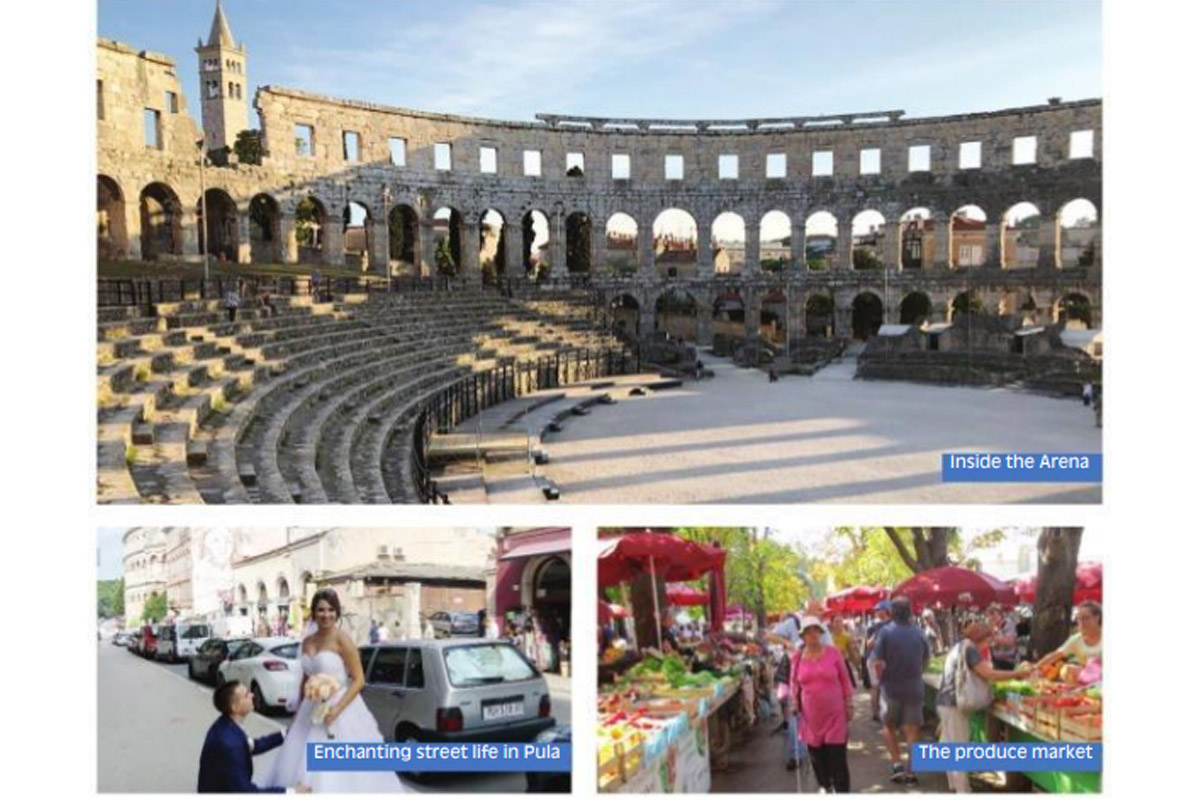Man tries to open airplane door midflight in Croatia
In an unusual incident aboard a Croatian flight, a professional boxer from Britain tried to open the door of the…
Citizens have made Pula an idyllic oasis, attracting discerning tourists from all over the world who cherish its warm, Mediterranean embrace.

It was a late spring morning. I was standing in Narodini Square, the Saturday meeting place for all generations of Pula. In the centre stands the market, surrounded by stands with fresh fruit and vegetables, and fish market with freshly caught fish and gifts from the sea, apart from snack bars, cafes and shops. This is where ingredients of a good Mediterranean meal, which goes so well with delicious local red or white wine, are sourced by locals. Slowly nursing my cappuccino in a corner café and by mingling with the murmurs of local voices that fills the air, I try to become, if only briefly, a citizen of Pula.
I have made Pula my prime European getaway, with encouragement from my friend Boris Suran, who is also the city’s former mayor. While rhythm of its daily life helps in calming my frayed nerves, life on its streets never fails to enchant me. Here, also is a Mediterranean town, where every house has a fruit and vegetable garden, including a micro vineyard. And, real rural homes and orchards are just a short drive away.
But, where exactly is Pula? Pula lies in the Adriatic, just a bay away from Venice. It is the most southern, most mature, and most beautiful among the bunch of heady and intoxicating Istrian towns of Croatia. Istria is an area through which thousands of years have strolled away, leaving their traces etched in its face. Romans, Venetians, AustroHungarians and finally Italians — all have left marks of their culture and architecture. Even today Istria is officially bilingual, using Croatian and Italian.
Advertisement
The Forum is the most beautiful square on the Adriatic Coast. Here are the City Hall that dominates with its Venetian architecture, reliefs and inscriptions, the imposing Temple of Augustus from the early Roman period, which stoically withstood the passing of centuries, the architecture of surrounding buildings freely jump from one century to another. The citizens of Pula consider the stone pavement of the Forum ideal for a break, looking at the temple of Augustus and the City Hall, under the old hackberry trees at Giardini.
From Forum a pedestrian-only street leads to the Franciscan Church and Monastery. Both are masterpieces of Gothic architecture. Strolling in the already smooth, rubbed-out stone paved street, I would find some very interesting facades representing the splendour of Venetian architecture. And, then walking up a winding path and following the steep stairs, I reach the Venetian Fortress at the top of the central hill. Locally called Kastel, it houses the Historical Museum of Istria. From here, there is an exceptional view over Pula and its bay. Its harbour is busy with myriad boats ferrying people to day trips, particularly to Briujni Island, which is a lush archipelago of forested islands, water bodies and myriad flora and fauna, apart from some more Roman ruins.
Continuing the stroll by the old defensive walls and along the promenade Giardini, I stand in front of another gem of Istrian monument — the Triumphal Arch of the Sergii. It was one of the rare monuments privately built by an early inhabitant of Pula. Built under the influence of the late Hellenic style, it is ornamented with exquisite details including two relief of the goddess Nika-Victoria. Two other gates from antiquity located nearby, namely Twin Gate and Hercules Gate, were built in the second and first century AD respectively. On the way, there are a few mosaics — on floors and pavements dating back from the early Roman era.
The most prominent of Roman monuments in Pula is the Collosesium, which has survived better than the one in Rome and it is probably the most elegantly beautiful amphitheatre in the world. Stone contours of the walls and the sea visible from their gaps juxtaposes to form an enchanting composition here. Locally called Arena, it is still being used for cultural events and houses coffee shops on the outer walls.
Despite all these attractions, most Western tourists do not stay near the city centre. Indeed, annually Pula attracts two million high-end European visitors for its 190 km of indented coasts, clean blue sea and spectacular islands nearby. So, there are many hotels and luxury resorts, along the coastal periphery of the city, like Novo Verudala, a huge complex of hotels, campsites and recreational areas amidst green coastal parks.
For the lovers of nature and sea, Pula’s sister island Medulin is another magnet for sea and sun seekers. The third area of interest in Prementura, a thin, finger like extension of Pula that ends at an unspoilt and uninhabited Kramniek Natural Park, where entry of cars is discouraged through high entry fees.
At the same time, Pula is one of the sparkling towns of new Croatia that is surprising visitors with its overall development. One notable such development is its artistic lighting industry —brilliant examples of decorative lighting could be seen in some monuments and rotundas on road crossings.
Local citizens of Pula, however, jealously try to keep the beauty and character of the city unspoilt from vagaries of modern day blights. For example, currently citizens are quite divided about the huge mall cum commercial complex being built near Stoja, an area with a green urban forest and beautiful beach, right in the middle of the city.
Indeed, its citizens have made Pula an idyllic oasis, attracting discerning tourists from all over the world who cherish its warm, Mediterranean embrace.
Advertisement